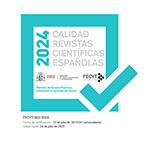Impact of the Sars-Cov-2 pandemic on gender-based occupational roles: Cross-Sectional Observational Study
Abstract
Introduction. Spain is one of the European countries most affected by the Sars-Cov2 pandemic despite preventive measures such as house confinement and strict social isolation among non-cohabiting citizens. This has had a major impact on the occupational level of the population and has led to a change in the occupational roles of individuals in society. The main objective of the study is to identify the impact that the Sars-Cov-2 pandemic has had on domestic tasks during confinement. Methodology. An observational, descriptive study was conducted between November and December 2020. An ad hoc questionnaire was conducted on the time spent on different aspects of daily life, including the EuroQol-5D quality of life questionnaire. Descriptive statistics, the Chi-square test (X2) and Student's t-test were used, as well as Cohen's d for quality of life in relation to effect size. Results. The study included a sample of 262 people. There is a relationship between gender and time spent on housework (p<0.001), home repairs, type of leisure activities, caring for others (p=0.010), work situation and quality of life, with women showing more anxiety and stress (t = - 3.229; p<0.001; d = 0.37). Discussion. The effects of the Sars-Cov-2 have affected the amount of time spent in both genders, confirming the presence of gender inequality in terms of the distribution of household chores, work and caregiving. A high percentage of women are currently suffering from anxiety and depression. The greater work overload in all areas has an impact on the quality of life.
Downloads
Article download
License
In order to support the global exchange of knowledge, the journal Investigaciones Feministas is allowing unrestricted access to its content as from its publication in this electronic edition, and as such it is an open-access journal. The originals published in this journal are the property of the Complutense University of Madrid and any reproduction thereof in full or in part must cite the source. All content is distributed under a Creative Commons Attribution 4.0 use and distribution licence (CC BY 4.0). This circumstance must be expressly stated in these terms where necessary. You can view the summary and the complete legal text of the licence.











